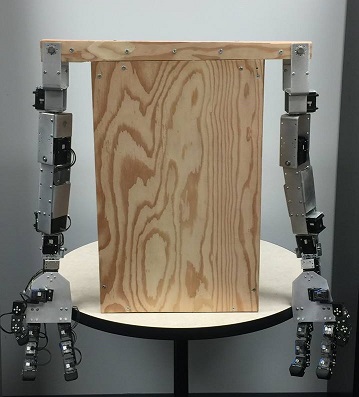Difference between revisions of "ASL-Robot"
(→Tutorials) |
(→Code) |
||
| Line 13: | Line 13: | ||
==Code== | ==Code== | ||
| − | * [[ | + | * [[Embedded System Control and Setup]] |
| − | + | * [[Data Smoothing for Motion Capture]] | |
| − | + | ||
| − | + | ||
==Videos== | ==Videos== | ||
Revision as of 13:12, 10 May 2016
The ASL, or American Sign Language Robot, is a prototype robot designed for the purpose of providing deaf children with an educational sign language resource. The arms are designed to have 80% the dexterity of a typical human and to perform signs at a rate of 2.3 signs per second. The robot consists of both 3D printed parts as well as machined components constructed from 6061 Aluminum. The arms and hands are assembled using servos from the dynamixel series. Each hand consists of 11 XL-320 servos daisy chained together, while each arm consists of an AX-12A, MX-28T, MX-64T, and 5 MX-106T's daisy chained together. The arms are mounted to a wooden stand using 2 thick planks. The robot functions using an MSP-432 Microcontroller. (add more)
A major goal of this project is to teach the robot signs via mapping from motion capture. (add info on simulation as well)
Contents
Tutorials
- Kinect Tutorial for Motion Capture
- Tutorial for Data Smoothing
- 3D Printing Tutorial
- Aluminum Machining Tutorial
